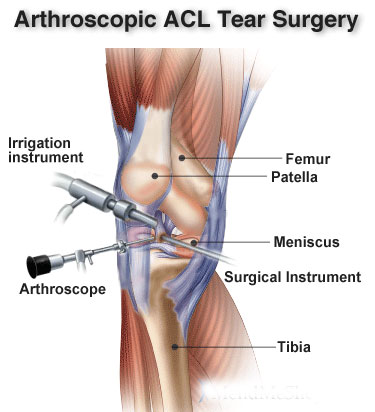Knee arthroscopy is a surgical procedure to view the knee joint without making a large incision. It is used to diagnose and treat a wide range of knee problems. During knee arthroscopy, the surgeon inserts a small camera, called an arthroscope, into your knee joint. The camera displays pictures on a video monitor, and your surgeon uses these images to guide miniature surgical instruments. Because the arthroscope and surgical instruments are thin, your surgeon can use very small incisions. This results in less pain for patients and often shortens the time of surgery.
Anatomy of Arthroscopy
The knee joint is the largest joint in the human body and one of the most complex. The knee bone includes the lower femur (thighbone), the upper tibia (shinbone), and the patella (kneecap).
Other important structures that the knee joint include:
- Articular cartilage. Articular cartilage covers the ends of the femur and tibia and the back of the patella. This slippery substance helps your knee bones glide smoothly.
- Synovium. Synovium surrounds the knee joint by a thin lining called. This lining releases a fluid that lubricates the cartilage and reduces friction during movement.
- Meniscus. Two wedge-shaped pieces of meniscal cartilage between the femur and tibia act as shock absorbers. Different from articular cartilage, the meniscus is tough and rubbery to help cushion the joint.
- Ligaments. Bones connect to other bones through ligaments. The four main ligaments in your knee act like strong ropes to hold the bones together.
When Knee Arthroscopy is Recommended
Your doctor may recommend knee arthroscopy if you do not respond to nonsurgical treatment. Nonsurgical treatment includes rest, physical therapy, and medications or injections that can reduce inflammation. Knee arthroscopy may relieve painful symptoms. It reduces many problems that damage the cartilage surfaces and other soft tissues.
Common arthroscopic procedures for the knee include:
- Meniscectomy (removal of the meniscus)
- Reconstruction of a ligament
- Removal of inflamed synovial tissue
- Trimming or reconstruction of damaged articular cartilage
- Removal of loose fragments of bone or cartilage, like those caused by synovial chondromatosis
- Treatment of patella (kneecap) problems
- Treatment of knee sepsis (infection)
Complications:
There are minor complications after arthroscopic surgery. Also, the recovery time is less compared to other surgical procedures. Still, if there are any complications, the doctor will handle the same symptomatically. Common complications include:
- Infection
- Blood clots
- Knee stiffness
- Accumulation of blood in the knee
- Swelling
Recovery in Arthroscopy
After surgery, you will be moved to the recovery room and should be able to go home within 1 or 2 hours. Be sure to have someone with you to drive you home. Recovery from knee arthroscopy is faster than traditional open knee surgery. It is important to follow your doctor’s instructions carefully after you return home.
Pain Management:
It is natural to experience pain after surgery. However, you can manage the pain with the medications. Medications give short-term pain relief after surgery. Many types of medicines are available to help manage pain. These include opioids, non-steroidal anti-inflammatory drugs (NSAIDs), and local anesthetics. Your doctor may use a combination of these medications to improve pain relief, as well as minimize the need for opioids. Talk to your doctor if your pain has not begun to improve within a few days of your surgery.
Outcome
Many people return to full, unrestricted activities after arthroscopy. Your recovery will depend on the severity of damage that was present in your knee. Unless you have had a ligament reconstruction, meniscus repair, or cartilage restoration, you should be able to return sooner. You may, however, need to avoid higher impact activities for a longer time. If your job involves heavy work, it might take longer before you can return to your job. You will be relieved from the pain and discomfort and lead a much better life after the surgery.
Key takeaway
There is no assurance that you will be affected by such issues in the future. On the other hand, if you’re a strong-willed person who doesn’t let his or her body fall prey to health-ailments, you might be able to avoid this one too. However, if you’re in one of the aforementioned situations, you can get rid of the problem with the medical facility in Nagpur. Contact Dr. Abhinav Bhatnagar, who is considered one of the best Orthopedic doctors in Nagpur. He can be consulted at Abhinav Multispeciality hospital, one of the best hospitals in Nagpur. Right treatment under the best hands is exactly what you need to live a pain-free and active life. Happy living!

